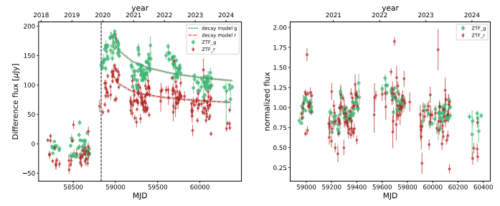2024-06-18 カリフォルニア工科大学(Caltech)
<関連情報>
- https://www.caltech.edu/about/news/the-awakening-of-a-massive-black-hole
- https://www.eso.org/public/archives/releases/sciencepapers/eso2409/eso2409a.pdf
SDSS1335+0728:約106M⊙ブラックホールの目覚め SDSS1335+0728: The awakening of a ∼ 106M⊙ black hole
P. Sánchez-Sáez, L. Hernández-García, S. Bernal, A. Bayo, G. Calistro Rivera, F. E. Bauer, C. Ricci, A. Merloni, M. J. Graham, R. Cartier, P. Arévalo, R. J. Assef, A. Concas, D. Homan, M. Krumpe, P. Lira, A. Malyali, M.L. Martínez-Aldama, A. M. Muñoz Arancibia, A. Rau, G. Bruni, F. Förster, M. Pavez-Herrera, D. Tubín-Arenas, M. Brightman
Astronomy & Astrophysics Published:May 27, 2024

ABSTRACT
Context. The early-type galaxy SDSS J133519.91+072807.4 (hereafter SDSS1335+0728), which had exhibited no prior optical variations during the preceding two decades, began showing significant nuclear variability in the Zwicky Transient Facility (ZTF) alert stream from December 2019 (as ZTF19acnskyy). This variability behaviour, coupled with the host-galaxy properties, suggests that SDSS1335+0728 hosts a ∼ 106M⊙ black hole (BH) that is currently in the process of ‘turning on’. Aims. We present a multi-wavelength photometric analysis and spectroscopic follow-up performed with the aim of better understanding the origin of the nuclear variations detected in SDSS1335+0728. Methods. We used archival photometry (from WISE, 2MASS, SDSS, GALEX, eROSITA) and spectroscopic data (from SDSS and LAMOST) to study the state of SDSS1335+0728 prior to December 2019, and new observations from Swift, SOAR/Goodman, VLT/X-shooter, and Keck/LRIS taken after its turn-on to characterise its current state. We analysed the variability of SDSS1335+0728 in the X-ray/UV/optical/mid-infrared range, modelled its spectral energy distribution prior to and after December 2019, and studied the evolution of its UV/optical spectra. Results. From our multi-wavelength photometric analysis, we find that: (a) since 2021, the UV flux (from Swift/UVOT observations) is four times brighter than the flux reported by GALEX in 2004; (b) since June 2022, the mid-infrared flux has risen more than two times, and the W1−W2 WISE colour has become redder; and (c) since February 2024, the source has begun showing X-ray emission. From our spectroscopic follow-up, we see that (i) the narrow emission line ratios are now consistent with a more energetic ionising continuum; (ii) broad emission lines are not detected; and (iii) the [OIII] line increased its flux ∼ 3.6 years after the first ZTF alert, which implies a relatively compact narrow-line-emitting region. Conclusions. We conclude that the variations observed in SDSS1335+0728 could be either explained by a ∼ 106M⊙ AGN that is just turning on or by an exotic tidal disruption event (TDE). If the former is true, SDSS1335+0728 is one of the strongest cases of an AGN observed in the process of activating. If the latter were found to be the case, it would correspond to the longest and faintest TDE ever observed (or another class of still unknown nuclear transient). Future observations of SDSS1335+0728 are crucial to further understand its behaviour.



